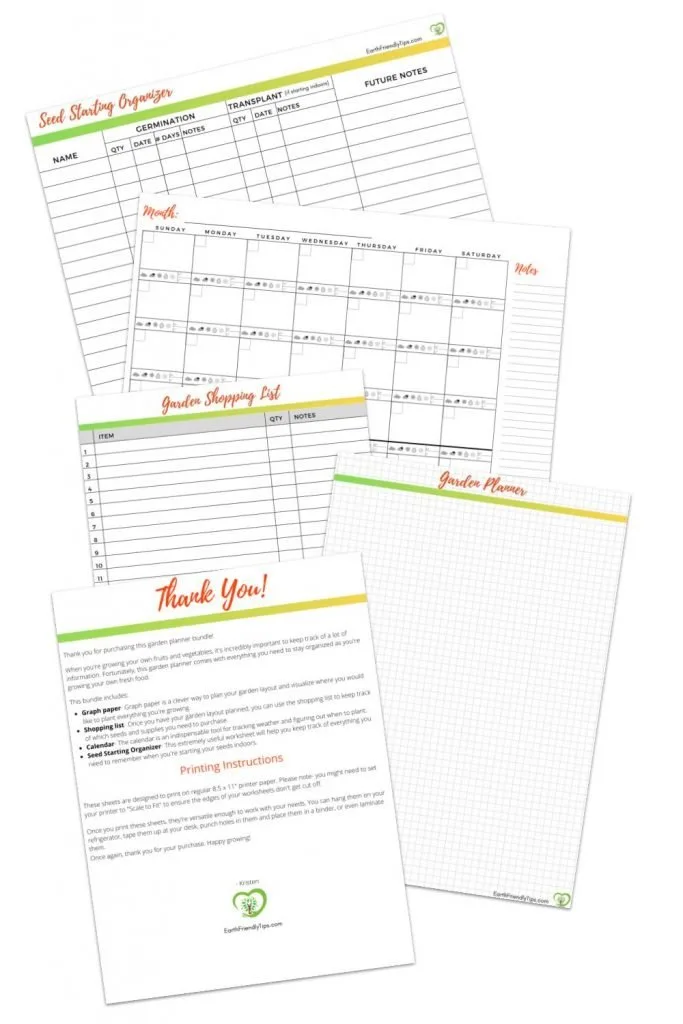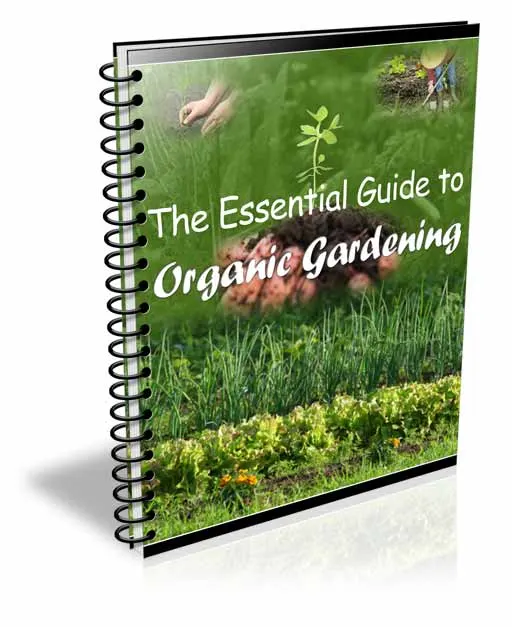How to Start a Garden
Gardening is a great hobby that offers a variety of outstanding benefits. If you want to start a garden but you’re not sure where to begin, this post will go over everything you need to know on how to start a garden.
Also, if you have to move your garden inside because of cold weather or lack of space, be sure to check out our helpful guide on how to start an indoor garden. It goes over a variety of tips so you can enjoy fresh fruit and vegetables throughout the year!
Begin With a Garden Planner
Believe it or not, the one thing that makes a huge difference between whether your garden barely produces anything or is overflowing with abundant food has nothing to do with sun or rain. It has to do with how organized you are!
Whether you’re interested in starting a garden but have no idea where to begin, or you’re tired of throwing seeds and transplants into your garden and hoping for the best, this printable garden planner is for you!

This is the exact planner I use to grow so much fresh food I have enough to feed my family AND give some away to friends and neighbors. You can also use it to take control of your garden and increase its productivity every year.
Once you grab your garden planner, you’re ready to handle these 10 steps on how to start a garden.
1. Decide What to Grow
Picking out what you want to grow is the very first step when you’re learning how to start a garden. Since you’re a beginner, consider vegetables that your family loves to eat. This can help you save money and reduce your dependence on the grocery store.
Related: Everything You Need to Know About Zero Waste Grocery Shopping
For example, my son loves green beans, so he grows some in his children’s garden. We also have a salad every evening with dinner, so we grow our own lettuce, tomatoes, and cucumbers.
Since you’re just getting started with gardening, start small with a few easy-to-grow plants that are good for beginners. If you need some more help deciding what to grow, these posts can also point you in the right direction:
- Plant Once and Harvest Forever: The Best Perennial Vegetables
- Fast Growing Vegetables for a Quick Harvest
- Best Vegetables to Plant in Summer
- Best Vegetables to Grow Indoors
- Top 15 Frost-Tolerant Vegetables to Grow in Winter
2. Get the Right Gardening Tools
Once you know what you want to grow, you’ll find gardening is easier with the right tools. While you can quickly go overboard and buy every tool you see, you should stick with these essential gardening tools.
When you’re shopping for your garden tools, skip the cheap, plastic equipment and purchase quality tools. Not only will this make it easier to garden and reduce your risk of injury, but it will also save you money in the long run since you won’t have to constantly buy new tools.
3. Pick the Right Spots
Different types of plants require different amounts of sunlight to survive. Some plants need full sun throughout the day to grow. Other plants require shade and won’t grow properly if they get too much sun.
As you’re planning your garden, take a look at your yard and notice how much sun you get during certain times of the day. This will help you make sure you put the right plants in the right spots.
Related: Gardening Subscription Boxes That Take the Guesswork Out of What to Plant
4. Choose Your Type of Garden
One of the great things about gardening is that it’s adaptable. We live in Florida, and we don’t really have soil in our backyard. We have sand. There’s not much that likes to grow in sand.
That’s why we have a container garden. Everything we need we can grow in pots and garden beds around our yard. Container gardens are also great for people who have small spaces.
If you live in an area that has rich and fertile soil, you might be able to plant directly in the ground. Raised garden beds are another great option to consider.
Are you interested in starting an organic garden to protect your health, the health of your family, and the environment, but you have no idea where to begin? Then check out The Essential Guide to Organic Gardening e-book!
You’ll discover the secrets you need to know to plan and grow a thriving organic garden without using toxic chemicals and other harmful substances. You’ll also learn all about organic fertilizers, organic compost, how to organically control pests, and more.
It’s never been more important to protect your loved ones from dangerous substances that can get into our food and to ensure you have a safe and reliable source of food, and this e-book will show you how!
5. Test Your Soil
Most plants like neutral soil with a pH around 7. However, just like different types of plants prefer different amounts of sunlight, they also like certain types of soil. For example, potatoes prefer a pH around 4.8 to 5.5, and cabbage likes a pH between 6.5 and 6.8.
If you’ll be planting your garden directly in the ground, it helps to know what type of soil you have. To do this, you can use a simple at-home soil test kit.
Once you know what type of soil you have, you’ll have a better idea of what you can successfully grow.
In addition to testing pH levels, you should also note the characteristics of your soil. Does it have a lot of clay, sand, or rocks? If so, you might have more success with a container garden.
6. Plant Your Seeds
After you’ve decided what type of garden you want and what type of plants you’re interested in growing, it’s time to plant your seeds. Most seed packets will tell you how deep to plant the seeds and whether it’s better to start indoors and transplant when temperatures are warmer or sow directly outside.
If you do need to start your seeds indoors, you don’t have to go out and spend extra money on seed starting pots. Instead, you can use toilet paper rolls to make your own seed starter pots.
Related: How Long Do Seeds Last in Storage?
7. Spread Some Mulch
Mulch helps keep moisture around the roots and prevents weeds from growing around your plants. Not only does this make sure your plants get the nutrients they need, but it also means you won’t have to water as much.
There are different types of mulch that range from shredded bark to rock. Since you’ll be growing vegetables to eat, I recommend you create your own compost that will naturally nourish your plants.
Related: The Best Organic Fertilizers for a Safer, Healthier Garden
8. Water Properly
If you don’t get enough rain, you’ll have to water your garden to help your plants survive. Of course, giving your plants too much water is just as bad as not giving them enough water.
You never want your seedlings to dry out, so you’ll likely need to water them daily. Transplants need watered every other day so their roots can establish. Once your plants get larger, you don’t need to water as frequently.
Keep in mind that sunny and windy conditions will dry out soil more quickly than cool and cloudy conditions. It’s also better to water in the morning to minimize evaporation.
One good way to know if it’s time to water is to feel the soil 3 to 4 inches below the surface. If it’s dry, it’s time to water.
Related: How a Garden Hose Water Filter Can Help Your Garden Grow
9. Tend to Your Garden
Watering isn’t the only thing you need to do to keep your gardening growing. You’ll also need to tend to your garden.
Watch out for weeds and pull them as soon as you see them. You should also trim off dead, dying, and diseased vegetation to keep your plants healthy. Tall plants like tomatoes and climbing plants like green beans will need a cage or trellis to help them grow.
If you spot any destructive insects on your plants, banish them right away with an organic solution. After all, if you’re going through the effort to learn how to garden so you can grow your own food, you don’t want to put toxins on what you eat.
Related: How to Make DIY Weed Killer
10. Enjoy Your Reward
Once your garden starts to mature and produce, it’s time to enjoy all of your hard work. Keep in mind that many plants will stop producing if their fruit stays on too long, so you should harvest regularly.
When you do harvest, you can use this homemade fruit and vegetable cleaner to make sure everything is clean and safe to eat. You can also check out some of these recipe collections for inspiration on what to make:
- Over 100 of the Best Vegetarian Recipes
- Simple Vegetarian Pantry Recipes
- Delicious Vegan Thanksgiving Recipes
- Easy Vegan Pantry Recipes
- Quick and Simple Vegetarian Instant Pot Recipes
How to Start a Garden for Beginners
Whether you’re interested in homesteading or simply trying to reduce your dependence on grocery stores, gardening is an important skill to master. Once you learn how to start a garden, you’ll have thriving plants that will offer plenty of health benefits and put food on your table.
More Eco-Friendly Living Tips
Now that you’ve learned how to start a garden, are you interested in even more great eco-friendly living tips? Then be sure to check out some of our other popular posts:
- Best Indoor Houseplants for Clean Air
- How to Naturally Get Rid of Ants
- How to Make DIY After-Sun Spray
- Incredible Homemade Stain Remover for Clothes




